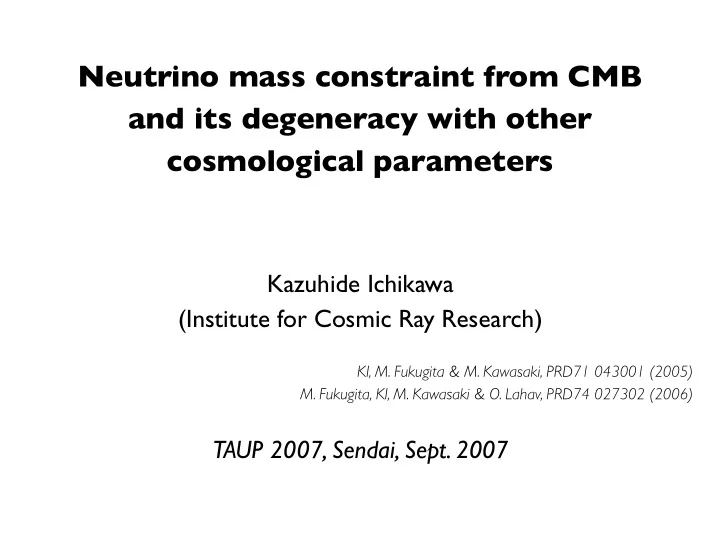

Neutrino mass constraint from CMB and its degeneracy with other cosmological parameters Kazuhide Ichikawa (Institute for Cosmic Ray Research) KI, M. Fukugita & M. Kawasaki, PRD71 043001 (2005) M. Fukugita, KI, M. Kawasaki & O. Lahav, PRD74 027302 (2006) TAUP 2007, Sendai, Sept. 2007
Introduction Tritium beta decay experiments: m ν e < 2 eV Cosmological bounds: WMAP1 Spergel et al. m ν < 0 . 2 eV +2dFGRS [WMAP collaboration] WMAP1 Tegmark et al. m ν < 0 . 6 eV +SDSS [SDSS collaboration] (3 . 8 eV for WMAP only) ? (main sample) Ichikawa, m ν < 0 . 7 eV Fukugita & WMAP1 Kawasaki Our results are confirmed by : Hannestad, hep-ph/0602058 Lesgourgues & Pastor, astro-ph/0603494
Effect of neutrino masses on CMB power spectrum (Equal masses for 3 neutrino species) for single species 6000 massless 0.5 eV 5000 0.7 eV / 2 π ( µ K 2 ) 1.0 eV 2.0 eV 4000 WMAP3 ℓ ( ℓ + 1) C T T 3000 ℓ 2000 1000 NOTE: when we vary neutrino mass, we fix CDM density and keep flatness. 0 0 100 200 300 400 500 600 700 800 900 1000 ℓ
1. Horizontal shift (to smaller multipoles) makes the distance to the last scattering m ν ↑ surface smaller. � m ν 1eV corresponds to Ω ν h 2 = Ω ν h 2 ∼ 0 . 03 94 . 1 eV But this effect is absorbed by decreasing the Hubble constant. m ν � 0 . 6 eV [Only for ] 2. Relative enhancement of 2nd or higher peaks w.r.t 1st peak The epoch of recombination z rec ~ 1088 ~ 0.3 eV Massive neutrinos become nonrelativistic before the m ν � 0 . 6 eV epoch of recombination if Characteristic signals imprinted in acoustic peaks.
recombination before Non-relativistic recombination after Non-relativistic 0.48 0.47 2nd peak height 0.46 1st peak height 0.45 0.44 0 0.2 0.4 0.6 0.8 1 1.2 m (eV) ν
We assume flat Lambda CDM model (6 parameters) + neutrino mass baryon density CDM density Hubble constant amplitude of fluctuation epoch of reionization a slope for the scalar perturbation Hubble constant (expansion rate at present): H 0 H 0 = 100 h km / s / Mpc
χ 2 analysis (We minimised over 6 other KI, Fukugita & Kawasaki, PRD71 043001 (2005) LCDM cosmological parameters) Fukugita, KI, Kawasaki & Lahav, PRD74 027302 (2006) 14 WMAP3 (full data) 12 WMAP3 (w/o polarisation) WMAP1 10 WMAP3 limit (95%CL) : 8 m ν < 0 . 7 eV 6 ~95% CL limit 4 2 0 0 0.2 0.4 0.6 0.8 1 1.2
WMAP3 limit (95%CL) : m ν < 0 . 7 eV Not improved from WMAP1 limit. WMAP1 has measured 1st and 2nd peaks well and the massive neutrino signal for >0.6 eV has been already rejected. The polarization data does not improve neutrino mass constraint much. Again, 1st and 2nd peaks in CMB TT power spectrum already provide sufficient information to constrain neutrino mass.
Conclusion for WMAP alone limit We follow up our previous study on constraining neutrino masses from WMAP 1st year data. We obtain m ν < 0 . 7 eV 3rd year data limit (95% CL): , not improved from the previous one as anticipated. This limit is quite robust: 1) Obtained from CMB data of WMAP , the cleanest cosmological data. 2) Using only single data set and avoiding to combine different data sets with different systematic errors. 3) Does not suffer from not-well-controlled issues of non-linearity or biasing which appear in e.g. galaxy clustering analysis. We have to combine other data sets in order to push the limit lower. But proper understanding of systematic errors involved in them is required.
H 0 ↓ m ν − H 0 degeneracy m ν ↑
) 6 Hubble constant from WMAP3 0 ) 0 1 74 ± 3 ± 6 2 0 ( assuming massive neutrinos 0 i 2 r c ( 0.85 a n M a m 72 ± 8 d e e 0.8 r F 0.75 0.7 h 0.65 ) 6 0 0 2 ( 0.6 e g a d n a 0.55 S 62 . 3 ± 1 . 3 ± 5 . 0 0.5 0 0.2 0.4 0.6 0.8 1 Hubble constant from m ν (eV) “cosmic distance ladder” [1 sigma Error bars]
) 6 Hubble constant from WMAP3 0 ) 0 1 74 ± 3 ± 6 2 0 ( assuming massive neutrinos 0 i 2 r c ( 0.85 a n M a m 72 ± 8 d e e 0.8 r F This is not the end of the 0.75 story ! 0.7 h 0.65 ) 6 0 0 2 ( 0.6 e g a d n a 0.55 S 62 . 3 ± 1 . 3 ± 5 . 0 0.5 0 0.2 0.4 0.6 0.8 1 Hubble constant from m ν (eV) “cosmic distance ladder”
Assume h is measured with a total uncertainty of 5% 0.85 A determination of H 0 to 5% (see Table 7) is a con- A determination of H 0 to 5% (see servative goal for the near term. It will require the re- servative goal for the near term. It 0.8 estimation of a maser distance to NGC Macri et al. ApJ 652, 1133, 2006 0.75 0.7 h 0.65 0.6 0.55 0.5 0 0.2 0.4 0.6 0.8 1 KATRIN: from 2010 to 2015~16 m ν (eV) “a neutrino mass of 0.35 eV could be determined with 5 sigma.”
Conclusion WMAP3 limit (95%CL) : m ν < 0 . 7 eV H 0 Degeneracy between and . m ν Uncertainty of is one of the largest m ν systematic errors for estimating cosmological parameters from CMB. If neutrino mass is detected to be > 0.3 eV, m ν it would be more consistent with the people claiming a small Hubble constant < 65.
Recommend
More recommend